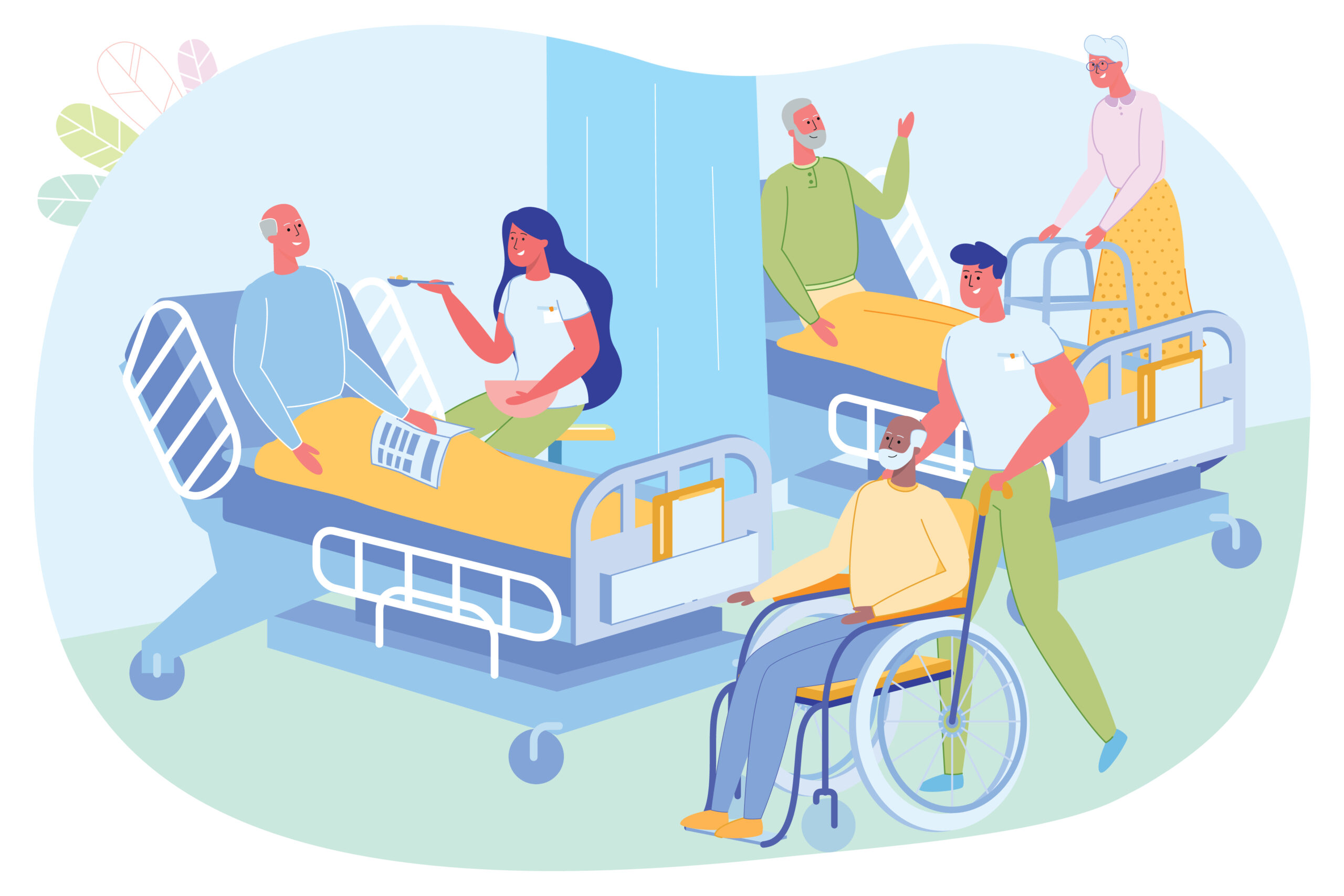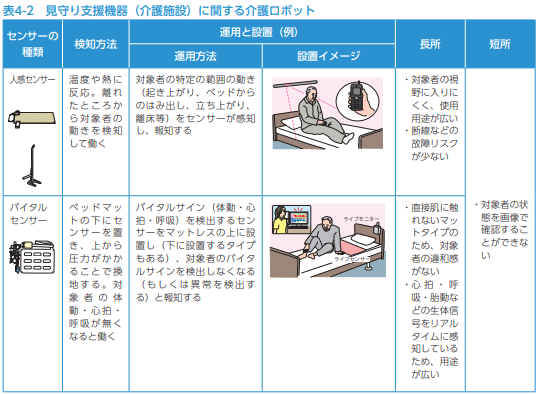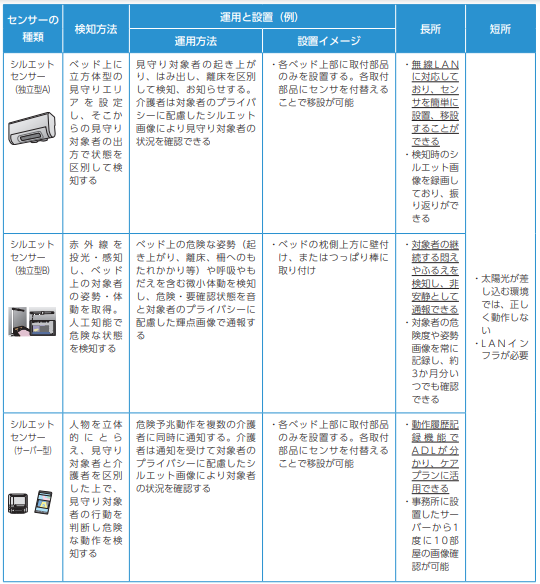ASOURCE®NAVI

公開日:2021.11.10
少子高齢化の進展とともに見守りの必要な高齢者が増加し、介護負担が増えています。介護施設では事故の大半が転倒や転落であり見守りが欠かせませんが、新型コロナの流行などの影響もあり、介護スタッフの不足や疲弊が大きな問題となっています。こうした状況を打開するために最新技術を活用した見守り機器を活用する動きがみられています。
見守り機器とは、介護施設などで利用者が使用するベッドや居室空間などにセンサーを設置し、システムと連携させることで、別の場所にいるスタッフに利用者の状況を知らせるものです。センサーから得られた信号は高度に処理され、単なる離床だけでなく多様な状況を認識し、利用者に応じた通知の設定が可能で、通知と合わせて画像情報も提供できるタイプがあります。これらの機器の特徴としては、①転倒につながる動作の検知可能、②端末で離れた場所からリアルタイムで状況把握が可能などで、最新型では③人工知能(AI)を搭載し、履歴・録画データの蓄積から利用者の動きを予測可能、④シルエット画像によるプライバシーの配慮が可能といった機能もあります。
見守り機器の主な種類としては以下に大別されます。①ベッドマットの下にセンサーを設置するタイプで、利用者の体動、心拍、呼吸などのバイタルサインを検知し、利用者のバイタルサインに異常を感知すると通知します。②利用者の居室の天井に画像処理技術を活かしたセンサーを取り付けるもので、このセンサーが室内の様子や利用者の動きをリアルタイムに分析し、臥床/離床や転倒など注意する必要がある動きを感知し、通知します。③ベットの枕側上方にセンサーを壁付けするもので、センサーから投光される赤外線を用いて、ベッド上の利用者の姿勢、体動を認識し、危険な状態を検知し通知します。AIを活用しているものもあります。暗い場所でも見守り可能で、シルエット画像で利用者の状況を確認します。④壁に取り付けるセンサータイプで、赤外線で起き上がり、端座位、柵越え、離床などを検知しますが、センサーカメラがベッド部分を3次元電子マットとして捉え、3Dでセンシングすることで動作を判断し、危険予兆動作を通知します。シルエット画像で利用者の状況を確認します。


厚生労働省 平成27年度 福祉用具・介護ロボット実用化支援事業 介護ロボット重点分野別講師養成テキスト
第4章 見守り支援機器(介護施設)より
国や自治体では、介護現場における介護ロボットやICT機器の活用を推奨しており、導入経費の負担を軽減する様々な支援を行っていますが、厚労省の「地域医療介護総合確保基金を活用した介護ロボットの導入支援」事業では、導入台数の8〜9割を見守り機器が占めています。
見守り機器の活用は、利用者の安全を守るだけでなく、介護スタッフの負担軽減となることが期待されています。厚生労働省の令和2年度介護ロボット導入支援及び導入効果実証研究事業では、介護施設における業務時間(直接介護と巡視移動時間)は、全居室に見守り機器を導入すると、業務時間が約26%減少するという調査結果が出ています。新型コロナウイルス感染症の流行を背景に介護人材不足はますます深刻さを増しています。介護職員数は2019年度時点で約211万人ですが、団塊の世代が75歳以上になる2025年度に約32万人、2040年度には約69万人が不足するともいわれています。
介護現場での見守り機器導入の取り組みは介護報酬でも評価されています。2021年度の介護報酬改定では、特別擁護老人ホームなどで見守り機器を導入した場合の夜勤職員配置加算の要件が緩和され、全ての入居者に見守り機器を導入した場合、夜間スタッフの最低基準に加えて配置する人数を0.9人から0.6人にしました。また、特養の日常生活継続支援加算、特定施設入居者生活介護の入居継続支援加算では、見守り機器やインカム、記録ソフトなどを活用した場合に、加算の介護福祉士の配置要件が6対1から7対1に緩和されました。
見守り機器の導入により介護スタッフの肉体的・精神的負担が減り、業務の効率化が図られ、介護の質の向上につながることが期待されています。
メディアスグループは、医療機器の販売を中心とした事業を展開しています。医療に携わる私たち(Medical+us)は、医療現場や人々の健康的な明日へ役立つ情報をお届けする情報発信源(Media)の役割も果たしていきたいと考えています。